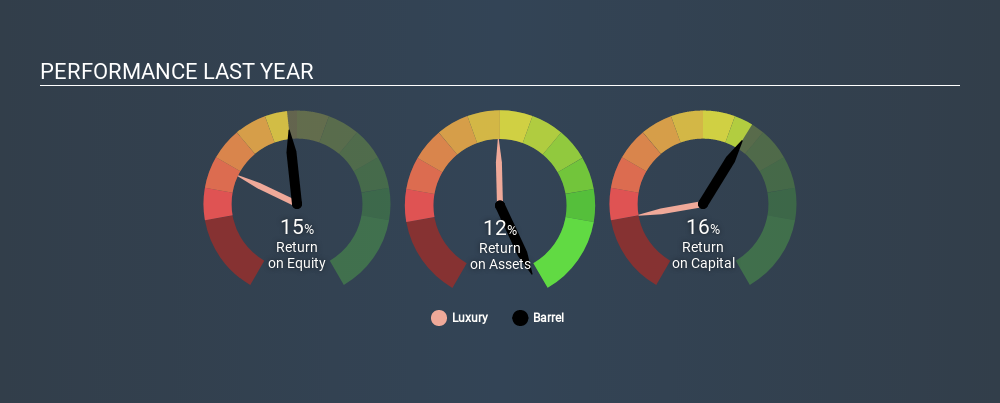- South Korea
- /
- Luxury
- /
- KOSDAQ:A267790
Barrel Co., Ltd (KOSDAQ:267790) Earns Among The Best Returns In Its Industry

Today we'll look at Barrel Co., Ltd (KOSDAQ:267790) and reflect on its potential as an investment. Specifically, we're going to calculate its Return On Capital Employed (ROCE), in the hopes of getting some insight into the business.
Firstly, we'll go over how we calculate ROCE. Second, we'll look at its ROCE compared to similar companies. Then we'll determine how its current liabilities are affecting its ROCE.
Return On Capital Employed (ROCE): What is it?
ROCE measures the 'return' (pre-tax profit) a company generates from capital employed in its business. In general, businesses with a higher ROCE are usually better quality. In brief, it is a useful tool, but it is not without drawbacks. Author Edwin Whiting says to be careful when comparing the ROCE of different businesses, since 'No two businesses are exactly alike.
So, How Do We Calculate ROCE?
The formula for calculating the return on capital employed is:
Return on Capital Employed = Earnings Before Interest and Tax (EBIT) ÷ (Total Assets - Current Liabilities)
Or for Barrel:
0.16 = ₩8.5b ÷ (₩58b - ₩4.9b) (Based on the trailing twelve months to December 2019.)
Therefore, Barrel has an ROCE of 16%.
Check out our latest analysis for Barrel
Is Barrel's ROCE Good?
ROCE can be useful when making comparisons, such as between similar companies. Using our data, we find that Barrel's ROCE is meaningfully better than the 8.7% average in the Luxury industry. We consider this a positive sign, because it suggests it uses capital more efficiently than similar companies. Regardless of where Barrel sits next to its industry, its ROCE in absolute terms appears satisfactory, and this company could be worth a closer look.
You can see in the image below how Barrel's ROCE compares to its industry. Click to see more on past growth.

When considering ROCE, bear in mind that it reflects the past and does not necessarily predict the future. ROCE can be misleading for companies in cyclical industries, with returns looking impressive during the boom times, but very weak during the busts. ROCE is only a point-in-time measure. How cyclical is Barrel? You can see for yourself by looking at this free graph of past earnings, revenue and cash flow.
Barrel's Current Liabilities And Their Impact On Its ROCE
Liabilities, such as supplier bills and bank overdrafts, are referred to as current liabilities if they need to be paid within 12 months. Due to the way ROCE is calculated, a high level of current liabilities makes a company look as though it has less capital employed, and thus can (sometimes unfairly) boost the ROCE. To counter this, investors can check if a company has high current liabilities relative to total assets.
Barrel has total assets of ₩58b and current liabilities of ₩4.9b. Therefore its current liabilities are equivalent to approximately 8.4% of its total assets. In addition to low current liabilities (making a negligible impact on ROCE), Barrel earns a sound return on capital employed.
What We Can Learn From Barrel's ROCE
This is good to see, and while better prospects may exist, Barrel seems worth researching further. Barrel looks strong on this analysis, but there are plenty of other companies that could be a good opportunity . Here is a free list of companies growing earnings rapidly.
I will like Barrel better if I see some big insider buys. While we wait, check out this free list of growing companies with considerable, recent, insider buying.
If you spot an error that warrants correction, please contact the editor at editorial-team@simplywallst.com. This article by Simply Wall St is general in nature. It does not constitute a recommendation to buy or sell any stock, and does not take account of your objectives, or your financial situation. Simply Wall St has no position in the stocks mentioned.
We aim to bring you long-term focused research analysis driven by fundamental data. Note that our analysis may not factor in the latest price-sensitive company announcements or qualitative material. Thank you for reading.
About KOSDAQ:A267790
Excellent balance sheet and good value.
Market Insights
Community Narratives


